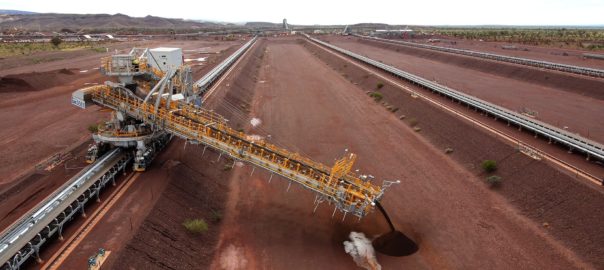A week after delivering first ore, Rio Tinto’s Gudai-Darri mine, in Western Australia, has officially been opened, marking a major milestone for the company’s most technologically advanced mine.
Pilbara Traditional Owners, the Banjima People, and Western Australia’s Minister for Mines and Petroleum; Energy, Bill Johnston MLA, today joined Rio Tinto employees as well as valued partners and suppliers to celebrate the official opening.
Since development commenced in April 2019, more than 14 million workhours have culminated in the delivery of Rio Tinto’s 17th and most technologically advanced iron ore mine in the Pilbara. Development of the mine supported more than 3,000 jobs during the construction and design phase with the operation requiring around 600 permanent roles.
With an expected life of more than 40 years and an annual capacity of 43 Mt, Gudai-Darri will underpin future production of Rio Tinto’s Pilbara Blend™ product. It’s expected to increase iron ore production volumes and improve product mix from the Pilbara from the second half of this year, the company says. The mine is expected to reach capacity in 2023.
To optimise mine safety and drive productivity, Gudai-Darri features an unprecedented deployment of technology, much of it industry-leading. This includes the use of robotics for the ore sampling laboratory as well as for distribution of parts in the new workshop.
This goes from autonomous trucks, trains and drills, standard across many Rio Tinto mines in the Pilbara, to a full digital replica of the processing plant which allows teams to monitor and respond to data collected from the plant. The same digital asset data is used to provide a feature rich, interactive 3D environment for virtual reality training. These autonomous assets are monitored remotely from Rio Tinto’s Operations Centre 1,500 km away in Perth.
The technology spread includes 23 Caterpillar 793F autonomous haul trucks and three Caterpillar MD6310 autonomous drills. The trucks, in this case, implement real-time ore tracking using sensors to provide live dig face progression, while data-informed modelling from the drills helps to build more accurate assessments of existing ground conditions and improve safety. In collaboration with Caterpillar, Rio Tinto is advancing the development of zero-emissions autonomous haul trucks. Once development is complete, it is anticipated the world’s first operational deployment of Caterpillar 793 zero-emissions autonomous haul trucks will be at Gudai-Darri.
Gudai-Darri also hosts the world’s first autonomous water carts.
The new vehicles, developed in partnership with Caterpillar, are primarily used for dust suppression on site, enhancing productivity by enabling mine operations to digitally track water consumption and reduce waste. The vehicle’s intelligent on-board system detects dry and dusty conditions on site, triggering the application of water to roads to keep them in good condition.
And, of course, it has autonomous trains under its AutoHaul™ system, which has been fully operational since June 2019.
The company has also invested in what it says is its first “rotable bucketwheel reclaimer”.
It explained: “Traditionally reclaimer maintenance requires a prolonged shutdown while several components are removed. This patented world first will enable the entire bucket wheel module to be changed out for maintenance, improving safety and efficiency.”
With the help of Scott Automation, the company has also introduced a robotic ore sampling lab on site, while its heavy mobile equipment warehouse is the home to four automatic guided vehicles.
Rio Tinto Iron Ore Chief Executive, Simon Trott, said: “We’ve worked closely with both the Banjima and Yindjibarndi People through the planning and development stages of Gudai-Darri and we look forward to partnering with them into the future to ensure the project achieves significant social and economic benefits.
“Gudai-Darri represents a step-change in the deployment of automation and technology within our iron ore business and a fantastic demonstration of the talent, ingenuity and capability that exists in Western Australia, a region which is now known globally for its technical excellence and innovation. Gudai-Darri’s combination of data and analytics, machine learning and automation, will make this mine safer and more productive.
“Gudai-Darri is our first greenfield mine in the Pilbara in more than a decade and a multi-billion-dollar investment in the State of Western Australia that will operate for decades to come.”
Western Australia’s Minister for Mines and Petroleum; Energy, Bill Johnston MLA, said: “I’m impressed by Rio Tinto’s innovation and sustainability; this is a prototype of the mine of the future. Once the new solar farm (a 34 MW farm consisting of about 83,000 panels) is complete it will be able to power one-third of Gudai-Darri’s operational needs with renewable energy.”
A total of A$3.2 billion ($2.2 billion) in goods and services were sourced within Western Australia during the construction phase of the Gudai-Darri Project with contracts valued at A$1.5 billion awarded directly to Western Australia-registered businesses such as NRW, Primero, DTMT Construction Company, Southern Cross Electrical Engineering and Monadelphous Engineering Associates.
This includes over A$100 million awarded directly to local Aboriginal businesses including White Springs, Lorrex Contracting, Hicks Civil & Mining, Brida, Karijini Development, Yurala Contracting Services, and Karlka FenceWright WA.







